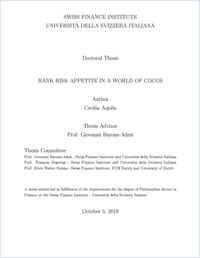Bank risk appetite in a world of CoCos
- Aquila, Cecilia
- Barone Adesi, Giovanni (Degree supervisor)
-
05.10.2018
120 p
Thèse de doctorat: Università della Svizzera italiana, 2018
Contingent convertible bonds
Risk appetite
Franchise value
Basel III
Growth opportunities
Impact
Tier 1 hybrids
Tier 2 hybrids
English
We investigate the shape of risk appetite when the bank is financed also with contingent convertible bonds (CoCos). Our contribution to the existent literature is to assess risk appetite in a multi-dimensional perspective and to account for differences among banks' clusters, especially in a world with CoCos and policy rates approaching zero or negative figures. In our model, the bank objective function is given by the sum of the default put option and the down-and-out call (DOC) option, pricing the net present value of growth opportunities. The manager maximizes the market value of the bank, adjusting jointly the level of leverage, the amount of CoCos to issue, assets and franchise value volatility and the policy rate. Risk appetite is given by the first order derivatives. Our model and Basel III recommendation converge over their incentives regarding volatility and leverage. For banks with higher franchise value, it is optimal to issue an average amount of CoCos (over the market value of the assets) of 3%. A decrease in volatility accrues to the DOC option, in particular for under capitalized banks. The optimal policy rate is always higher with respect to the actual one. The optimal value for the decision variables differs among the clusters. We show that for the bank, it is always better to issue CoCos with respect to write-down bonds. We conduct an empirical analysis on the whole spectrum of CoCos and WDs available over the time span 2009 - September 2015. We argue that the impact of those hybrid instruments on the bank investment policy is non- monotonic. It is described by a U-shaped curve for bank riskiness and by a inverted-U curve for bank growth.
- Language
-
- English
- Classification
- Economics
- License
-
License undefined
- Identifiers
-
- RERO DOC 327172
- URN urn:nbn:ch:rero-006-118677
- ARK ark:/12658/srd1319187
- Persistent URL
- https://n2t.net/ark:/12658/srd1319187
Statistics
Document views: 424
File downloads:
- Texte intégral: 263
